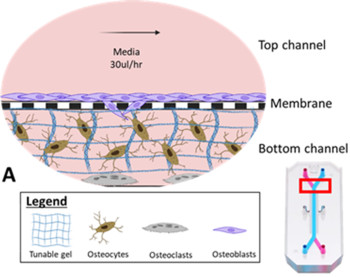Project
Tuneable mechanical microenvironments for organ-chip models - a case study in bone
| Primary Investigator: | Dr Stefaan Verbruggen Queen Mary University of London |
| Co-investigator: | Prof Hazel Screen Queen Mary University of London |
| Funder: | Emulate+Network Proof of Concept Award |
| Project dates: | 01-03-2023 to 01-06-2023 |
| Centre dates: | 03-04-2023 to 01-06-2023 |
Organ-on-a-chip models present exciting opportunities to mimic in the lab what our cells experience inside our bodies, and could be used in place of animals for discovering and testing new treatments. A key challenge for these models is fully capturing the physical environment that cells sense when in our various organs, which can vary widely from hard organs like bone to soft organs like skin. If this crucial new technology is to be more widely adopted in industry and the clinic, then we will need to be able to precisely tune how hard or soft these 3D environments are, and control this in a standardised and repeatable manner.
Of all the tissues in the body, bone is one of the most sensitive to changes in physical stimuli, and is composed of very hard matrix filled with very soft marrow. These properties are known to change from our youth to old age, but quite how this affects our bone health is very poorly understood. As our population is rapidly getting older this is becoming an ever-more-urgent clinical research question, and provides the perfect test case for developing standardised protocols for tuning matrix stiffness.
This project will inject hydrogels of tuneable stiffness into these organ-chips, generating 3D microenvironments of differing mechanical properties for bone cells. By carefully modifying the properties of these gels, and testing the resulting environments, we will generate a catalogue of microenvironments that will be shared with the field. Furthermore, by observing the behaviour and gene expression of the bone, we will understand how best to mimic human bone tissue, and deliver a bone-on-a-chip device that can be used for further research and for drug testing.



